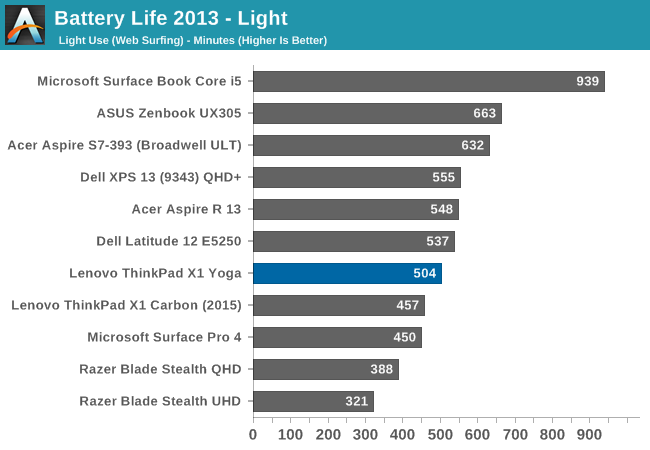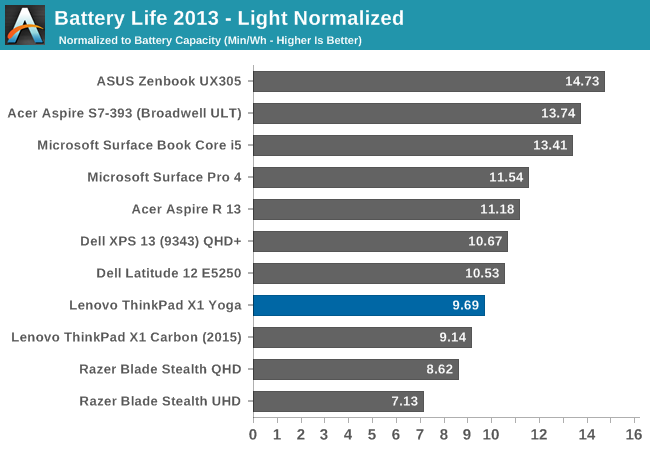The Lenovo ThinkPad X1 Yoga Review: OLED and LCD Tested
by Brett Howse & Brandon Chester on September 29, 2016 11:30 AM ESTBattery Life
For some people, performance is king, and others like a great design. Some crave great displays and some love the flexibility of a convertible device. The one thing everyone can pretty much agree on is that the battery life of a mobile device is important. Over the last couple of years, the increases in battery life due to hardware and software changes has been pretty dramatic. Notebooks that used to last an hour or two can now make it a whole working day, and others have exploited new power paradigms to rule the roost. Processors, displays, storage, and wireless cards are all more efficient than before, and even battery capacity has increased quite a bit. Despite the thin and light convertible design, Lenovo has managed to squeeze a 52 Wh battery inside the X1 Yoga. Battery capacity seems to be a moving target, with every generation seemingly increasing in size.
It is worth noting that initially there were some issues testing battery life due to the Windows 10 Anniversary Update. The method in which Edge was invoked in our tests raised some issues with Edge crashing. This gave me the chance to implement a new battery life test that I’ve wanted to do for a while. For now, the existing 2013 Light test will be maintained, although for 2016 it is just too light, as you’ll see. Going forward, the same test we utilize for our smartphones and tablets will be used. This test is noticeably heavier on the CPU and gives a better angle for real-world results.
2013 Battery Life Light

Coming in at 504 minutes, or almost 8.5 hours, the X1 Yoga with the higher resolution display is middle of the road in the light test. It does outlast the 2015 X1 Carbon by about three quarters of an hour, and the specifications are pretty similar, meaning there is improvement in the design.
2016 Web Battery Life (The New Test, starting with this review)
Since this is a new test, it has only been run on the X1 Yoga, but we were able to run it on the OLED version as well. OLED has a power advantage when displaying dark images, since it only uses power to create light. In movies and such, it has proven to be a great advantage for consuming content. But there is a power penalty for OLED when doing many typical office tasks, such as spreadsheets, documents, and web browsing, since all of these activities tend to emphasize white backgrounds (in typical Windows OS environments at least). Web browsing has a pretty high average picture level (APL) for white, and as such there is a penalty for this on OLED.

On our more difficult web browsing test, the OLED version achieved 3h39 for battery life, compared to 6h11 on the LCD model. Both have the same resolution and hardware (aside from SATA vs NVMe), so most of the delta should come down to the display. The OLED model had 41% less battery life than the LCD model in this test, which, although one of the worst case scenarios for OLED, is also something that a majority of people will use quite a bit. Although OLED has some amazing gamut and contrast, in our new test it can’t touch an LCD for power efficiency when doing typical office tasks.
Normalized Results
Removing the battery size from the equation allows an equal-footing display of platform efficiency. Some laptops have large batteries but only use that to mask power draw issues, while others can make a smaller battery last for a lot longer.

The X1 Yoga LCD model is not the most power efficient laptop around, with a normalized result on our light test of under ten. It is a minor improvement on the X1 Carbon from 2015, but an improvement nonetheless.

On the 2016 test since we just have the two results, it is difficult to draw much of a comparison at this time.
Charge Time
The other side of mobility is charge time. Even with a device that has a low battery life, being able to top up quickly can help mitigate that.

Lenovo has tended to do very well on this test, and the X1 Yoga is the fastest charging laptop tested yet. Zero to 100% in less than two hours is very good. It is helped quite a bit by the inclusion of a 65-Watt AC adapter, which is quite a bit larger than what most Ultrabooks ship with.










84 Comments
View All Comments
Ej24 - Thursday, September 29, 2016 - link
Nope. There are at least two or three 15w "U" processors with Iris 540 and one 28w U processor with iris 550. The 580 graphics are only reserved for HQ (35-45w) and S (65w) processors. I'd love just to have iris 540. The typical 520, 4400, or 4000 Intel graphics are hardly good enough for light gaming at 720 or heavier loads during hardware decode/encode or the 50/50 software hardware hybrid pipelines Intel has been using.Ro_Ja - Thursday, September 29, 2016 - link
All of the GeForce with *40 and below are just a waste of good money now since the Iris HD 580 can stack up against even a 940M. I can hardly find a laptop in our country without any horrible AMD EXO Pros and NVIDIA's crappy entry-level cards. I just want less heat on the laptop I want to use.spikebike - Friday, September 30, 2016 - link
I have a NUC with the Iris 540. It's pretty nice, handles the occasional light gaming, WebGL games, Minecraft, http://slither.io, and related much better than the non-iris graphics.forgot2yield28 - Friday, September 30, 2016 - link
CAD. Not a huge niche, but Iris will outperform standard intel integrated GPU. Sometimes architects/engineers want to get work done on the road. The small footprint and lightweight of an ultrabook still has appeal.Byte - Thursday, September 29, 2016 - link
Would love to get this, but all the Yogas i've had had tons of hardware bugs that were near impossible to fix. Just getting the touchpad right took a few days of fiddling. If only they can get things working.Samus - Thursday, September 29, 2016 - link
Working in IT, I can back you up on one thing for sure. These machines are hell to work on. I've had to replace two fans in Thinkpad Yoga 12.5's and they are, in traditional Lenovo fashion, not detachable from the heat pipe (which is why they failed in the first place...the bearing is in direct-contact with the source) so the whole assembly needs to be needlessly replaced, instead of just popping the cover off with a latch and unscrewing two screws like you do in just about any modern HP Elitebook.The real insult to the Thinkpad Yoga line is the dreaded history of the battery "non-recall" that caused the Yoga 14 machines to hard power off if bumped in the front right corner where the battery is connected. This connection is very sensitive and the only way we found to help prevent this anomaly was to insulate the battery connection internally on every model we came across.
Routine repair by Lenovo would result in a machine returned with the same exact problems. Dealing with Lenovo support is like dealing with a car dealership. They don't listen to your problem and the mechanic runs their standard tests, says its ok, and returns it to the customer. They don't seem to have a system in place to diagnose specific issues.
Brett Howse - Thursday, September 29, 2016 - link
It already throttles GT2. Going to GT3e would help because of eDRAM but likely throttle even more.ajp_anton - Friday, September 30, 2016 - link
Sure it throttles, nobody would expect an Iris 540 to go full speed at 15W. But with double the EUs and half the frequency, you get the same performance but at lower power (lower frequency allows for lower voltage). Wider GPUs generally have higher performance per watt because of this, at the expense of higher cost.Senti - Thursday, September 29, 2016 - link
I expect USB type-C in what you call "premium notebook" today. And better than Intel HD 520 graphics...It's sad to see that OLEDs are still "not quite ready". Battery life with web browsing was the last nail in the coffin.
BrokenCrayons - Thursday, September 29, 2016 - link
It's not bad hardware, but it does seem overpriced. Given the GPU choice, the panel resolution is too high for the graphics card to effectively drive it. 1080p is a stretch for the 520 doing anything intensive. Lenovo should offer a lower resolution & cheaper option. I can't see the usefulness of the hinge design either. Desktop operating systems work a lot better with access to a keyboard and mouse (or touchpad) so owners are probably paying for a novelty feature they'll rarely put to use.